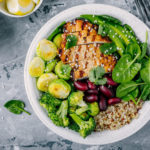Health Hints for the Junk Food Generation?
Would you please include more tips to help our young people become healthier? I teach school and could use help educating students about how to become better informed in preventing health problems.
Andrew Weil, M.D. | February 21, 2003

Like adults, young people need to learn the basics of good nutrition and understand other elements of a healthy lifestyle – the benefits of exercise, for example, as well as the importance of stress reduction and the avoidance of dangerous habits such as overeating, smoking, and drug use. Young people also need good role models for healthy living and defenses against the commercial pressures that tend to undermine the good habits that underlie good health.
Depending on the age of your students, you may want to approach the subject of a healthy lifestyle by discussing two recent events. One was a case of scurvy (vitamin C deficiency) diagnosed in a college student whose diet consisted entirely of cheese, crackers, cookies, chocolate, soda, and water but no fruits and vegetables to provide him with vitamin C. Scurvy causes bleeding gums, loose teeth, muscle degeneration and weakness. It once was rampant among sailors who spent months at sea with no access to fresh fruits or vegetables. British sailors eventually learned to prevent the disease by drinking lime juice – hence the nickname “limeys.”
Another topic that might interest your students was the recent dismissal of a suit against McDonald’s brought on behalf of millions of teenagers by two New York girls who accused the chain of deceiving them about the high levels of fat, sugar, salt and cholesterol in its products. One of the girls is 4-foot-10 and weighs 170 pounds. The other is 5-foot-6 and weighs 270 pounds. Both claimed to be regular McDonald’s customers. In dismissing the case, the judge said that it is widely known that fast food contains high levels of potentially harmful ingredients. (We may not have heard the last of this suit – the judge left the door open for a complaint that the processing of fast food may create an “entirely different – and more dangerous – food” than one would expect at home or in another type of restaurant.) The issues raised here may create a springboard from which you can interest your students in the difference between nutritious and unhealthy food and the other elements of a healthy life style.
Andrew Weil, M.D.











